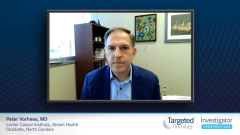
Unmet Needs and Future Directions in the Management of Multiple Myeloma
Considerations for future unmet needs and novel therapies in multiple myeloma, followed by practical advice for community oncologists.
Episodes in this series

Transcript:
Peter Voorhees, MD: Are there remaining unmet needs? Yes. In particular, high-risk patients continue not to fare as well as their standard-risk counterparts. Better understanding of why those patients aren’t doing as well and developing new strategies to treat their disease and overcome that high-risk status is going to be critical going forward. As far as interesting drugs or combinations in the pipeline, it goes without saying that there’s a tremendous amount of excitement, both in the CAR [chimeric antigen receptor] T-cell therapy space, as well as in the bispecific monoclonal antibody space. With regard to CAR T-cell therapy, we already have our first accelerated FDA approval of idecabtagene vicleucel, which is a BCMA-targeted CAR T-cell therapy. We’ll hear about potential accelerated approval of ciltacabtagene autoleucel later this year, another BCMA-targeted CAR T-cell product. There are other CAR T-cell products in development that are targeting other antigens on the surface of myeloma cells, which will definitely be of interest, and next-generation CAR T cell directed against BCMA.
With regard to the bispecifics, the BCMA bispecifics are performing incredibly well. We have new targets on plasma cells for bispecifics as well. There’s talquetamab, which targets GPRC5D, which is a very plasma cell–specific marker. That’s been performing exceptionally well in the initial clinical trial. Then we have cevostamab, which is also directed more specifically against plasma cells and has demonstrated very promising response rates in heavily pretreated patients. Then we’ve got the new version of IMiDs [immunomodulatory imide drugs], or CELMoDs [cereblon E3 ligase modulators]. There’s iberdomide—Cc220, as it was formally referred to—and then CC-92480. Those are performing very well also. What we’re going to see in the years ahead is all these things being moved to earlier therapy and eventually patients with newly diagnosed multiple myeloma in varying combinations. As far as the results are concerned, we’ll see if they’re going to be transformative.
As far as practical advice for community oncologists treating multiple myeloma, in the newly diagnosed space the number of treatment options is fewer than in the relapse space, and treating those patients is a lot easier. There are very good data emerging on incorporating the CD38 antibodies, both in transplant-ineligible and transplant-eligible myeloma patients. For relapse patients, it’s very daunting. When you look at the NCCN [National Comprehensive Cancer Network] Guidelines, for example, for relapsed myeloma, you have this gigantic menu of treatment options. That can be very daunting for someone who doesn’t treat myeloma on a day-in, day-out basis. In those circumstances, don’t hesitate to reach out to someone who treats multiple myeloma for a living and engage us. Ask for our advice as far as optimal therapy because it’s changing all the time.
Transcript edited for clarity.









































